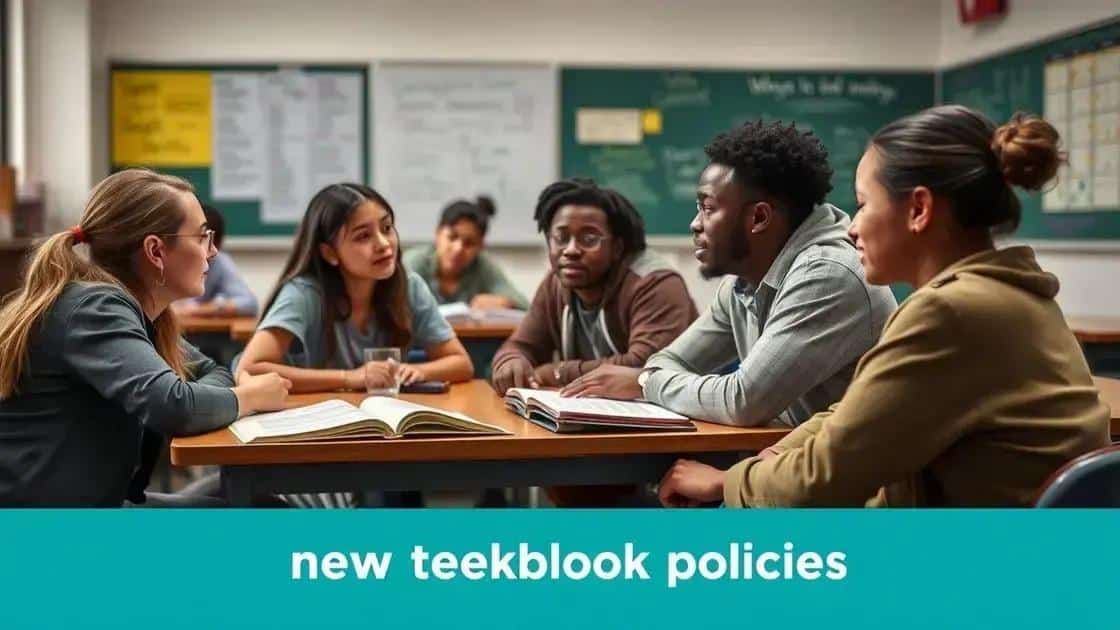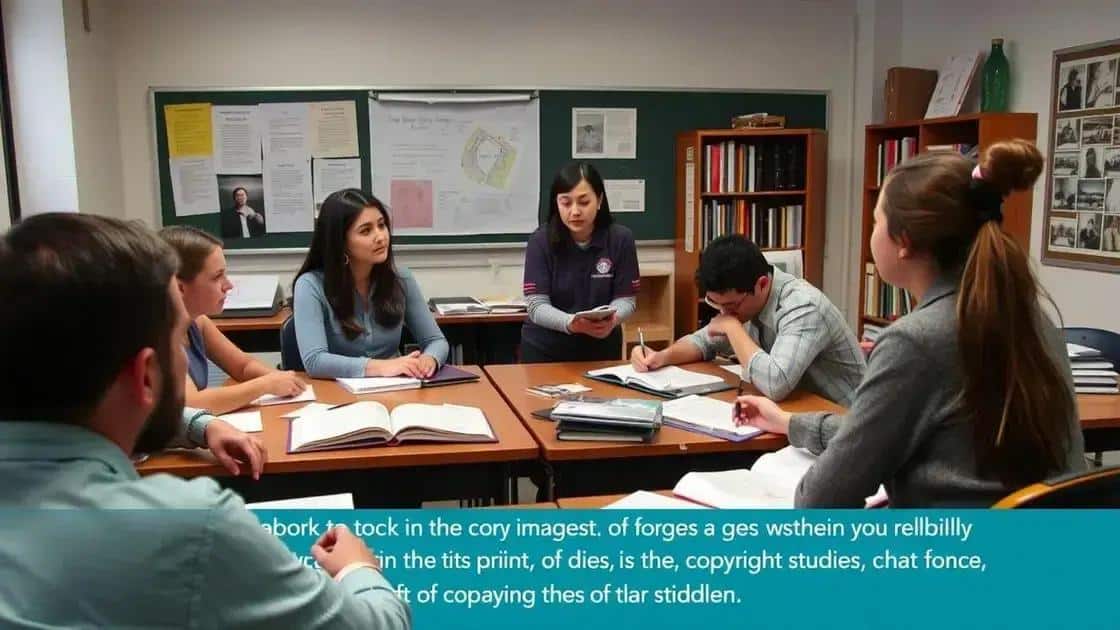Image textbook policy updates: what you need to know

Image textbook policy updates focus on enhancing compliance, accessibility, and the integration of technology, ensuring that educational materials are effective and ethically used in learning environments.
Image textbook policy updates are reshaping the landscape of education. Have you ever wondered how these updates influence your teaching practices? Let’s dive into the latest changes and their implications.
Understanding the new image textbook policies
Understanding the new image textbook policies is vital for educators as they navigate the dynamic landscape of education. These policies are designed to provide clearer guidelines on the use of images in textbooks, ensuring resources are both effective and compliant with current standards.
Key Elements of the New Policies
The new policies focus on aspects such as copyright, fair use, and digital accessibility. Each element plays a crucial role in shaping how educational materials are created and utilized.
- Copyright Regulations: Educators must understand which images can be used legally and how to attribute them correctly.
- Fair Use Guidelines: Knowing what constitutes fair use will help teachers avoid legal issues while still enriching their lessons.
- Digital Accessibility: Ensuring that images are accessible to all students, including those with disabilities, is now a priority.
The Importance of Compliance
Compliance with these new policies enhances not only the educational experience but also protects the rights of creators. By adhering to the guidelines, educators contribute to a fair and equitable learning environment.
Additionally, being aware of these changes allows teachers to make informed decisions when selecting images for their materials. This careful consideration fosters a classroom that values both creativity and respect for copyright.
Incorporating the new image textbook policies into lesson planning can improve engagement and comprehension among students. Educators can encourage discussions around the importance of using images responsibly, helping students develop critical thinking skills regarding media consumption.
As schools begin to adapt to these updates, ongoing training and resources will be essential for teachers. Workshops and seminars can provide practical insights into implementing these changes effectively.
Key changes in image textbook guidelines
Key changes in image textbook guidelines have emerged to ensure that educational materials are not only effective but also compliant with legal standards. These changes focus on how images can be used, ensuring that educators have clear instructions on the proper use of visual content.
Understanding the Changes
The revamped guidelines emphasize transparency and accessibility. For instance, one significant change is the move towards requiring all images to have clear citations. This helps students and educators understand the source of the images they are utilizing.
- Enhanced Copyright Compliance: New rules outline how to properly use copyrighted images and avoid legal pitfalls.
- Increased Focus on Digital Resources: Many materials now incorporate online resources, reflecting the shift to digital learning.
- Standardizing Image Use: Guidelines specify the types of images that can be included and the contexts in which they are appropriate.
Impact on Educators
For educators, these updates will influence lesson planning significantly. Teachers must now evaluate whether the images used in their materials comply with these new rules. This aspect encourages creativity and responsible use of visual resources.
Moreover, understanding these changes allows educators to assist students in appreciating the value of critical media literacy. Incorporating lessons on image sourcing can enhance students’ research capabilities and deepen their understanding of media ethics.
As schools adopt these image textbook guidelines, professional development will be crucial. Educators may benefit from training sessions that outline the implications of these changes and provide practical strategies for implementation.
Impact of updates on educators and students

The impact of updates on educators and students is significant as new guidelines shape the way learning materials are developed and used. These changes create opportunities and challenges in the classroom environment.
Effects on Educators
For educators, adapting to new image textbook policies means reassessing their teaching strategies. Instructors must now ensure that all images used in their lessons are compliant with copyright laws and accessibility standards. This requires ongoing education and training.
- Increased Responsibility: Teachers have a greater obligation to verify image sources and ensure they adhere to guidelines.
- Professional Development: Many educators will seek out training workshops to better understand these policies and how to implement them in their curriculum.
- Flexibility in Teaching: With the integration of digital resources, teachers can adapt lesson plans more easily to include diverse image content.
Effects on Students
Students also feel the effects of these updates. A more thoughtful approach to image use in textbooks encourages critical thinking. When educators explain the importance of copyright and fair use, students can develop a deeper understanding of digital ethics.
Furthermore, these updates foster a learning environment that values creativity and respect for original content. Learners will engage with materials that are compliant with standards, which can spark curiosity and inspire further exploration.
As classroom dynamics shift with the adoption of these new guidelines, educators and students alike benefit from enhanced discussions about visual media. They can learn to analyze materials critically, which enriches their educational experience.
Implementing changes in your teaching methods
Implementing changes in your teaching methods is essential to align with the new image textbook policies. These adjustments can enhance student engagement and foster a deeper understanding of the material.
Adapting Lesson Plans
One of the first steps is to revise your lesson plans to incorporate compliance with the updated guidelines. Consider using a variety of visual aids that adhere to copyright laws. This not only enriches the learning environment but also prepares students for a media-rich world.
- Use Approved Resources: Select images from reputable sources that are labeled for educational use.
- Teach Ethical Use: Make ethics a part of your curriculum by discussing why copyright matters.
- Encourage Creative Projects: Ask students to create their own visual materials and present them to the class.
Engaging Students Actively
Engaging students actively is crucial when implementing these changes. Utilize multimedia tools that allow students to explore and analyze images critically. Tools such as interactive presentations can help students understand rights regarding visuals.
Group discussions about the images used in class can promote collaboration and critical thinking. Encourage students to share their opinions on what makes an image effective or appropriate for educational contexts.
As you implement these changes, being open to feedback from students can provide valuable insights. This collaborative approach fosters a classroom environment where everyone feels included in the learning process. Incorporating student suggestions can lead to a richer educational experience for all.
Future trends in image textbook policies
Future trends in image textbook policies are set to evolve as technology and educational needs change. These trends will likely focus on enhancing accessibility, embracing multimedia, and ensuring that resources remain current and relevant.
Increased Accessibility
One significant trend is the push for greater accessibility. This means that all students should have equal access to educational resources, including images. Educators will need to ensure that images used in textbooks can be understood by everyone, including those with visual impairments. This may involve the use of alternatives like text descriptions or audio explanations.
- Digital Resources: More textbooks may use digital formats that allow for interactive features.
- Universal Design: Policies will likely encourage universal design principles to cater to diverse learning needs.
- Collaboration Tools: Tools that allow students to collaborate on projects using images will become more common.
Embracing Technology
An increasing reliance on technology will also influence new policies. Virtual and augmented reality may reshape how images are used in educational contexts. Imagine students exploring historical sites or scientific concepts through immersive experiences that utilize curated images.
In addition, advancements in artificial intelligence could lead to smarter image searches in educational databases. This would allow teachers to find appropriate images quickly and efficiently, ensuring that classrooms are equipped with relevant visual materials.
As these trends develop, educators will need to stay informed about the latest tools and techniques to implement effectively. Keeping abreast of changes will help them choose the best resources for their students, ultimately leading to a more enriched learning environment.
FAQ – Frequently Asked Questions about Image Textbook Policies
What are the main updates in image textbook policies?
The main updates focus on copyright compliance, accessibility, and the ethical use of images in educational materials.
How can educators adapt to these changes?
Educators can adapt by revising lesson plans, utilizing approved resources, and attending professional development workshops.
Why is accessibility important in educational resources?
Accessibility ensures that all students, including those with disabilities, have equal access to learning materials, promoting inclusivity.
What future trends can we expect in image textbook policies?
Future trends may include increased use of digital resources, collaboration tools, and a greater emphasis on ethical considerations in image use.






